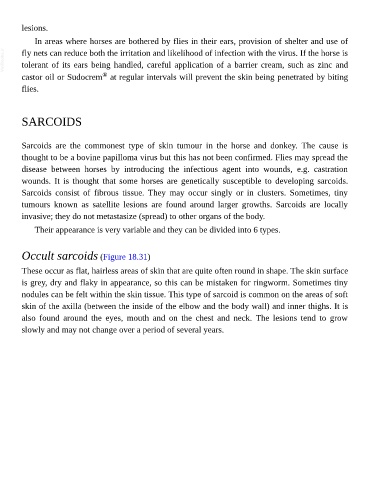Page 882 - The Veterinary Care of the Horse
P. 882
lesions.
In areas where horses are bothered by flies in their ears, provision of shelter and use of
VetBooks.ir fly nets can reduce both the irritation and likelihood of infection with the virus. If the horse is
tolerant of its ears being handled, careful application of a barrier cream, such as zinc and
®
castor oil or Sudocrem at regular intervals will prevent the skin being penetrated by biting
flies.
SARCOIDS
Sarcoids are the commonest type of skin tumour in the horse and donkey. The cause is
thought to be a bovine papilloma virus but this has not been confirmed. Flies may spread the
disease between horses by introducing the infectious agent into wounds, e.g. castration
wounds. It is thought that some horses are genetically susceptible to developing sarcoids.
Sarcoids consist of fibrous tissue. They may occur singly or in clusters. Sometimes, tiny
tumours known as satellite lesions are found around larger growths. Sarcoids are locally
invasive; they do not metastasize (spread) to other organs of the body.
Their appearance is very variable and they can be divided into 6 types.
Occult sarcoids (Figure 18.31)
These occur as flat, hairless areas of skin that are quite often round in shape. The skin surface
is grey, dry and flaky in appearance, so this can be mistaken for ringworm. Sometimes tiny
nodules can be felt within the skin tissue. This type of sarcoid is common on the areas of soft
skin of the axilla (between the inside of the elbow and the body wall) and inner thighs. It is
also found around the eyes, mouth and on the chest and neck. The lesions tend to grow
slowly and may not change over a period of several years.

